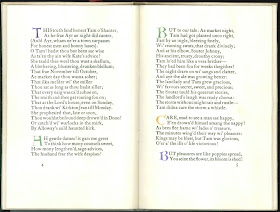 In 1897, Charles Ashbee set up the Essex House Press. He hired many of the craftsmen originally employed by William Morris at the Kelmscott Press to pursue his own utopian dream of art, craft and labor united. Like Morris before him, he espoused a socialist ideal and actually put it into practice in his worker-owned shop. But also like Morris, the output of his press was far too expensive for the working class.
In 1897, Charles Ashbee set up the Essex House Press. He hired many of the craftsmen originally employed by William Morris at the Kelmscott Press to pursue his own utopian dream of art, craft and labor united. Like Morris before him, he espoused a socialist ideal and actually put it into practice in his worker-owned shop. But also like Morris, the output of his press was far too expensive for the working class.The book is a model of restrained extravagance that is aesthetically positioned between the over-the-top typography of Kelmscott and the austerity of Doves Press. It is a book that draws you in with its beauty but invites you to read with its clean presentation of the text.
You can see it in the context of the Kelmscott Press between now and August 30th in the Class of 1965 Galleries in Rauner Library in the exhibit When Adam Delved and Eve Span: William Morris and the Politics of the Book. After August 30th, ask for Presses E78bu.


No comments:
Post a Comment